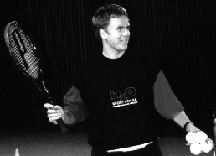|
Juniors Lessons

The Right Approach to Tennis Drills, Part Two
 by Stefan
Lundgren, TennisONE International Contributing Editor by Stefan
Lundgren, TennisONE International Contributing Editor
Preface
I have spent the last two years working full time on a
computer program, Computer Tennis - Practice Drills, which contains a number
of practice drills (http://www.buller.se/usr/stefan.lundgren/ell-hs.htm).
This work has lead to many questions and many rewarding discussions with
knowledgeable tennis persons all over the world. During these two years
I have also given a number of lectures on the subject practice drills, and
these discussions and lectures are the basis of this series of articles.
Contents
Part Two: Quality in Practice Drills
What can be done to increase the quality in the beginning of the drill?
- Communicate the goal: Tell the pupils what the purpose of the
drill is before it is started. One reason for this is the pupils have to
know what they are practicing, but it is also so that they will understand
that you have a plan.
- Explain: Explain calmly and make sure that all the pupils understand
the drill before it starts. There are few things that are as annoying for
players and coaches as when someone has not understood the drill and the
coach has to explain it again. For certain drills, it is useful to tell
everyone how long you plan to do the drill. In particular, before up-tempo
drills, let the players know how long the drill will last so they don't
worry about fatiguing.
- The coach demonstrates: A good way to show how the drill is
done is to show it together with a player. This decreases the chances for
mistakes and the coach does not have to explain in as much detail.
- Start slowly: The players have to feel that they can do the
drill from the beginning. Once the drill works, the intensity can be increased.
- Returning to drills that have been done before: This way you
do not have to spend time on explaining drills. One idea can be to name
the drills so you can initiate the drill just by saying the name.
What can be done to improve the quality during the drill?
- Practice resting: It is better to practice in short intervals
and then break for rests. The quality of the drill will suffer if it lasts
too long.
- To change positions as a coach: If you do a drill where the
coach's only assignment is to get the ball started, it is a good idea for
the coach to walk around during the drill in order to be in close contact
with all the players, which increases their motivation.
- Counting points: If the drill does not involve playing for points
from the beginning, this can be added when the players are beginning to
get a little tired. Playing for points usually increases the motivation
and the fighting spirit, even among tired players.
- Pep-talk: Pep-talks from the coach to the player are a must,
but pep-talks from player to player are even more important. It is important
to teach the players to help each other on the court from an early age.
- Succeed: It is important that the players feel that they succeed
in doing the drill, as is expected of them. If the players do not do this,
the quality of play usually decreases fast. Thus, it is important to find
the right drill for the right players.
What can be done to sustain the quality in the end of the drill?
- Adding a new level to the drill: This could be playing for points
but also adding an attack situation to a baseline drill. This makes the
players more alert and the motivation is increased.
- Say the remaining number of balls/time: By saying this, an exhausted
player can find new strength since he/she knows when the drill will be
over.
- Play for a reward: This can be a good way for the players to
recharge their batteries. For instance, the winning player will not have
to collect balls.
- Break with a new drill as a form of "active rest":
To plan a tennis-related game or a fun drill when the players are getting
tired and losing their concentration helps the players to recharge their
batteries, so that they can go back to the tougher drill with renewed strengths.
|
|
